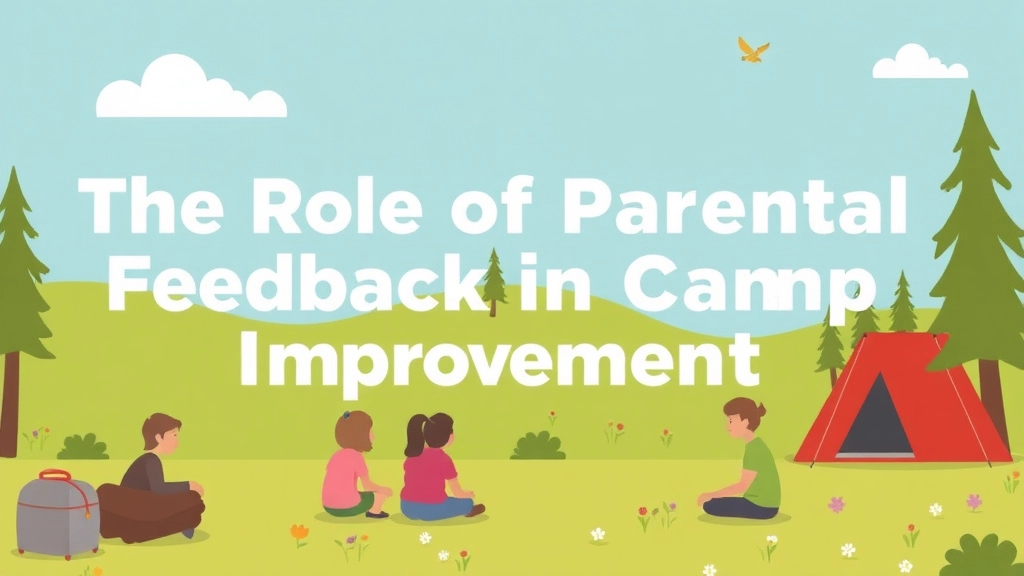Creating a Summer Camp Survey for Parents
Creating a summer camp survey for parents is essential for gathering valuable feedback that can help improve your camp’s offerings. As a camp organiser, understanding parents’ perspectives on activities, safety, and staff performance is crucial for ensuring satisfaction and building trust. By crafting thoughtful questions and distributing the survey at the right time, you can gain insights that will guide your future camp sessions.
Key Components to Focus On
When designing your survey, focus on key components such as:
- Overall camp experience
- Specific activities
- Quality of staff interactions
Tools and Incentives
Use tools and platforms that make it easy for parents to provide feedback, and consider offering incentives to increase participation. Analysing the results will help you identify areas for improvement and act on the feedback to enhance your camp programs, ensuring a better experience for both parents and children in the future.
Key Components of a Successful Summer Camp Parent Survey
Alright, let’s get straight to it. You want to make sure your summer camp is the best it can be, right? And who better to ask than the parents who trust you with their kids? But how do you make a parent survey that actually gets you the feedback you need? Here’s the lowdown.
Why a Parent Survey?
First off, why even bother with a parent survey? Well, it’s simple. Parents are your customers. They pay for the camp, they drop off the kids, and they pick them up. They see the whole picture. Their insights can help you:
- Improve camp activities
- Enhance safety measures
- Boost overall satisfaction
What Makes a Good Survey?
A successful parent survey isn’t just a bunch of random questions thrown together. It’s got to be well-thought-out and structured. Here are the key components:
1. Clear Objective
What do you really want to know? Are you looking to improve the food options, the activities, or maybe the staff performance? Be specific.
2. Simple and Direct Questions
No one likes to spend ages on a survey. Keep your questions short, simple, and to the point. Avoid jargon and complex language.
3. Balanced Question Types
Mix it up with different types of questions:
- Multiple Choice: Easy for parents to fill out quickly.
- Rating Scales: Great for gauging satisfaction levels.
- Open-Ended Questions: Allows for detailed feedback.
4. Logical Flow
Your survey should flow naturally. Start with general questions and get more specific as you go along. This keeps parents engaged and less likely to abandon the survey halfway through.
5. Anonymity
Guarantee anonymity to get honest feedback. Parents are more likely to be candid if they know their comments can’t be traced back to them.
6. Mobile-Friendly
Everyone’s on their phones these days. Make sure your survey is mobile-friendly so parents can fill it out on the go.
Real Concerns Addressed
Parents have real concerns about summer camps. Are their kids safe? Are they having fun? Are they learning something new? Address these worries head-on in your survey.
Sample Questions
Here are some examples to get you started:
- How satisfied are you with the safety measures at the camp? (Rating Scale)
- What activities did your child enjoy the most? (Multiple Choice)
- Do you have any suggestions for improving the camp experience? (Open-Ended)
Stories and Examples
Let me share a quick story. Last summer, we got feedback from a parent who was concerned about the lack of vegetarian meal options. We didn’t realise it was a big deal until we saw similar comments from other parents. Guess what? This year, we added more vegetarian options, and the feedback has been overwhelmingly positive. Sometimes, it’s the little things that make a big difference.
If you’re looking for tips on setting up a successful camp canteen, check out our guide on summer camp canteen snacks and spending tips.
Best Practices for Survey Timing and Distribution

Alright, let’s get real. When should you send out those summer camp parent surveys? Timing is everything, right? You don’t want to send it too early or too late. Let’s break it down.
The Perfect Timing
1. Post-Camp Sweet Spot
- Right After Camp Ends: Parents’ experiences are fresh. They remember what worked and what didn’t.
- Two Weeks Post-Camp: Gives parents a bit of breathing room but keeps the experience top of mind.
2. Avoid the Black Hole
- Not During Holidays: Parents are busy. Your survey will get lost.
- Not During Major Events: Think school starts or big sports seasons. Timing is key.
Distribution Done Right
1. Email is Your Friend
- Direct Email: Most parents check their emails regularly.
- Use a Catchy Subject Line: “Help Us Improve Next Summer!” or “Your Camp Feedback Matters!”
2. Go Multi-Channel
- Social Media: Share the survey link on your camp’s Facebook, Instagram, or Twitter.
- Camp Website: Have a prominent link on your homepage.
3. Make it Mobile-Friendly
- Responsive Design: Parents are on their phones. Make sure your survey looks good on mobile.
- Short and Sweet: Keep it concise. Nobody wants to scroll forever.
Real Talk: Common Concerns
1. “Will my feedback even matter?”
- Reassure Them: Let parents know their opinions will shape next year’s camp.
2. “I don’t have time for this.”
- Keep It Quick: Aim for a 5-minute completion time.
3. “Is this anonymous?”
- Ensure Anonymity: Guarantee that their responses are confidential.
Pro Tips for Engagement
1. Personal Touch
- Address Parents by Name: Use their first name in the email.
- Thank Them in Advance: Show appreciation for their time.
2. Incentives Work
- Offer a Prize: A small discount on next year’s camp or a gift card can go a long way.
- Raffle Entry: Enter survey respondents into a draw for a cool prize.
3. Follow-Up
- Reminder Emails: Send a gentle nudge if they haven’t filled out the survey.
- Update Them: Share how you’ve used past feedback to make improvements.
Real Example: The Johnson Family
The Johnsons loved the camp but thought the food could be better. They filled out the survey right after camp ended. They appreciated the short, mobile-friendly format and were thrilled to see their feedback led to a new menu next year.
Crafting Effective Survey Questions for Parents
Let’s dive straight into the nitty-gritty of crafting effective survey questions for parents. You know, the kind that actually gets you the feedback you need to make your summer camp the best it can be. Trust me, this is where the magic happens.
Why Parents’ Feedback Matters
First off, let’s address the elephant in the room. Why should you even bother with parents’ feedback? It’s simple. Parents see things from a different angle. They notice stuff that you might miss while you’re knee-deep in camp activities. Their insights can be gold.
What Parents Are Really Worried About
Parents often have a ton of questions and worries about summer camps. Here are a few common ones:
- Is my child safe?
- Are the activities engaging and educational?
- How are the staff members?
- Is my money well spent?
Addressing these concerns directly in your survey questions can make a world of difference.
Breaking Down Effective Survey Questions
Alright, let’s get into the meat of it. Crafting survey questions isn’t rocket science, but there’s a method to the madness. Here are some tips to help you out:
1. Keep It Simple and Direct
- Avoid jargon. Use plain, straightforward language.
- Ask one thing at a time. Complex questions can confuse people.
2. Use a Mix of Question Types
- Closed-ended questions: Great for yes/no answers or multiple-choice options. For example, “Was the camp staff friendly and approachable?”
- Open-ended questions: Perfect for getting detailed feedback. For example, “What did your child enjoy the most about the camp?”
3. Be Specific
- Instead of asking, “Did your child have fun?” ask, “Which activities did your child enjoy the most?”
- Specific questions yield more actionable insights.
4. Scale Questions
- Use a Likert scale to gauge satisfaction levels. For example, “On a scale of 1 to 5, how satisfied were you with the camp’s safety measures?”
Real-World Examples
Imagine you’re sitting down with a parent over coffee. Here’s how you might frame some questions:
- “Hey, how did you feel about the variety of activities we offered at the camp?”
- “Was there anything about the camp’s daily schedule that you think could be improved?”
- “What was your child’s favourite part of the camp, and why?”
Making It Engaging
Keep it real, keep it fresh. You don’t want your survey to feel like a chore. Make it engaging by:
- Adding a personal touch: “We’d love to hear your thoughts on how we can make next summer even better.”
- Using friendly language: “Got any suggestions for us? We’re all ears!”
For more tips on creating an engaging camp experience, check out our Engaging Summer Camp Curriculum Guide.
The Role of Parental Feedback in Camp Improvements

Why Does Parental Feedback Matter?
Ever wondered how to make your summer camp better?
Parental feedback is the secret sauce.
Parents see things we might miss.
They know their kids and can spot what works and what doesn’t.
Real Concerns from Parents
Parents worry about:
- Safety
- Activities
- Staff behaviour
- Communication
They want to know their kids are having fun and learning.
And they’re not shy about telling us what’s up.
How Feedback Drives Change
When parents talk, we listen.
Here’s how we use their insights:
- Safety Improvements: If parents flag safety issues, we fix them. Fast.
- Activity Updates: Boring activities? Gone. We replace them with what kids love.
- Staff Training: If parents have concerns about staff, we ramp up training.
- Better Communication: Clearer updates, more photos, and real-time info.
Turning Feedback into Action
Here’s a quick rundown on how we do it:
- Collect Feedback: Surveys, emails, and face-to-face chats.
- Analyse Data: Look for patterns and common issues.
- Make Changes: Implement improvements before the next session.
- Follow Up: Let parents know what’s been fixed. They’ll appreciate it.
Examples to Keep It Real
Last summer, a few parents mentioned that the lunchtime options were lacking.
Kids were hungry and cranky.
We revamped the menu, added healthier snacks, and guess what?
Happy kids, happy parents.
Utilizing Survey Data to Enhance Camp Offerings
Alright, let’s tackle the big question: How do we use survey data to make our summer camp better? Parents have a lot to say, and if we listen closely, we can turn their feedback into action. The goal here is simpleâkeep it real, keep it fresh, and keep it engaging. Let’s dive in.
Why Bother with Survey Data?
First off, why should we even care about survey data? Well, think about it. Parents are the ones who see the camp from a different angle. They notice things we might miss. Plus, their feedback can help us:
- Identify strengths and weaknesses
- Understand parent expectations
- Spot trends and common issues
- Make data-driven decisions
What to Look For in Survey Data
When sifting through survey data, keep an eye out for:
- Recurring themes: If multiple parents mention the same issue or praise the same feature, it’s worth paying attention to.
- Outliers: Sometimes, a single comment can highlight a unique perspective or a hidden problem.
- Quantitative metrics: Ratings and scores can give you a clear picture of overall satisfaction.
Turning Data into Action
Once you’ve got the data, it’s time to roll up your sleeves and get to work. Here’s how to turn that feedback into tangible improvements:
- Prioritise Issues
Not all feedback is created equal. Focus on the issues that affect the most parents or have the biggest impact on the camp experience. - Create an Action Plan
Break down the feedback into actionable steps. For instance:- If parents are unhappy with the food, consider revamping the menu or hiring a new caterer.
- If safety is a concern, review and update your safety protocols.
- Involve the Team
Share the feedback with your staff. They’re on the front lines and can offer valuable insights on how to implement changes. - Communicate Changes
Let parents know what actions you’re taking based on their feedback. This not only shows that you’re listening but also builds trust and engagement.
Real-World Example
Let me share a quick story. Last summer, we received several comments about the lack of shade in our outdoor activity areas. Parents were worried about their kids getting too much sun. We took this feedback seriously and installed more shaded areas and provided extra sunscreen stations. The result? Happier kids, happier parents, and a safer camp environment.
Keeping It Fresh
Remember, using survey data isn’t a one-time thing. Keep the feedback loop going. Regularly check in with parents and make adjustments as needed. This continuous improvement mindset will keep your camp offerings fresh and relevant.
For more tips on enhancing your camp experience, check out our Ultimate Summer Camp Pack List and learn from the Top Picks for Boys and Girls Summer Camps 2024.
Tools and Platforms for Creating Parent Surveys

Alright, let’s talk tools and platforms.
You’ve got a summer camp, and you need feedback from parents.
But where do you start?
What tools do you use to create those surveys?
Let’s break it down.
Why Tools Matter
First off, the right tools make your life easier.
You don’t want to spend hours figuring out how to send a survey.
You want something quick, effective, and easy to use.
Top Tools for Creating Parent Surveys
Here are some of the best tools out there:
Google Forms
- Free and easy: Google Forms is a no-brainer. It’s free and super easy to use.
- Customisable: You can add different types of questions—multiple choice, short answer, and more.
- Real-time results: See responses as they come in.
SurveyMonkey
- User-friendly: SurveyMonkey is another popular option.
- Templates: It offers ready-made templates to get you started.
- Analytics: Built-in analytics help you understand the data.
Typeform
- Interactive: Typeform makes surveys interactive and engaging.
- Visuals: Add images and videos to make it more appealing.
- Easy to use: Drag-and-drop interface makes it simple.
JotForm
- Customisable: JotForm offers a lot of customisation options.
- Integrations: Integrates with other tools like Google Sheets and Dropbox.
- Templates: Plenty of templates to choose from.
Microsoft Forms
- Integrated: Great if you’re already using Microsoft Office.
- Simple: Easy to set up and share.
- Real-time collaboration: Collaborate with other staff members in real-time.
Real Concerns Parents Have
Parents want to know their feedback matters.
They worry their opinions will be ignored.
Using these tools can show them you’re serious about listening.
Pro Tips for Using These Tools
- Keep it short: No one likes a long survey. Aim for 5-10 minutes max.
- Be clear: Use simple language. Don’t confuse parents with jargon.
- Mobile-friendly: Make sure your survey works on mobile devices.
- Test it: Send a test survey to a few parents first to catch any issues.
Increasing Participation Through Incentives and Anonymity
Hey there, camp organisers! Struggling to get parents to fill out those summer camp surveys? You’re not alone. Many of us face the same issue. But don’t worry, I’ve got some killer tips to help you boost participation. Let’s dive in.
Why Aren’t Parents Filling Out Surveys?
Before we jump into solutions, let’s tackle the common questions and worries parents have:
- “What’s in it for me?” â Parents are busy. They need a reason to spend time on your survey.
- “Will my feedback be anonymous?” â Some parents might hesitate to be honest if they think their comments will be traced back to them.
- “Does my opinion even matter?” â If parents feel their feedback won’t lead to real change, they won’t bother.
How to Get Parents Onboard
Alright, let’s chop this up into bite-sized tips:
Offer Incentives
- Gift Cards: Everyone loves a free coffee or a discount at a popular store.
- Camp Discounts: Offer a small discount on next year’s camp fees.
- Raffles: Enter respondents into a draw for a bigger prize.
Ensure Anonymity
- Anonymous Surveys: Use tools that guarantee anonymity. Parents will feel more comfortable being honest.
- Clear Communication: Tell parents upfront that their responses are anonymous. Make it crystal clear.
Show You Care
- Feedback in Action: Share stories of changes made based on past feedback. “Thanks to your feedback, we added more outdoor activities this year!”
- Personal Touch: Send a thank-you note after they complete the survey. A little appreciation goes a long way.
Make It Easy
- Short and Sweet: Keep the survey short. Aim for 5-10 minutes max.
- Mobile-Friendly: Ensure the survey works well on mobile devices. Most parents will fill it out on their phones.
Real-Life Example: The Power of Incentives and Anonymity
Let me share a quick story. Last year, we struggled with low survey participation. So, we decided to offer a £10 Amazon gift card to every parent who completed the survey within the first week. We also used a survey tool that guaranteed anonymity and made sure to communicate this clearly. Participation skyrocketed, and the feedback was incredibly honest and useful.
For more tips on engaging parents and making your summer camp a success, check out our Top Summer Camp Tips for Parents and Kids. Also, don’t miss our guide on Ultimate Summer Camp Starter Pack Essentials for everything you need to know about packing for camp.
Strategies for Analysing Parent Survey Results

Alright, you’ve got a stack of parent surveys. Now what?
How do you turn this pile of feedback into actionable insights?
Let’s dive into some killer strategies for analysing parent survey results.
Break It Down
First things first, don’t get overwhelmed.
Chunk the data into manageable parts.
- Categorise responses (e.g., facilities, activities, staff).
- Look for patterns and recurring themes.
- Quantify the data. Use percentages to get a quick snapshot.
Use the Right Tools
You don’t need to be a data scientist.
But you do need some basic tools.
- Excel or Google Sheets for sorting and filtering.
- Survey platforms like SurveyMonkey or Google Forms often have built-in analytics.
- Data visualisation tools like Tableau can make complex data easier to digest.
Look for Trends
What are the parents saying?
- Positive feedback: What’s working well? Keep it up.
- Negative feedback: What needs fixing? Prioritise these areas.
- Neutral feedback: Often overlooked but can provide insights into areas that are just ‘meh’.
Use Real Examples
Imagine parents are saying the food quality was poor.
That’s a red flag.
But if only one parent says it, maybe it’s an outlier.
If 50% of parents say it, you’ve got a problem.
Drill Down
Sometimes you need to dig deeper.
- Cross-tabulate data to see if certain issues are more prevalent in specific groups (e.g., parents of younger kids vs. older kids).
- Segment by demographics to understand if certain issues are tied to specific age groups, locations, or other factors.
Actionable Insights
Turn feedback into a game plan.
- Quick wins: Easy fixes that can be implemented immediately.
- Long-term goals: Bigger projects that need planning and resources.
- Pilot changes: Test improvements in smaller groups before a full rollout.
Share the Findings
Don’t keep the data to yourself.
- Share insights with the team.
- Create a summary report for stakeholders.
- Communicate changes to parents. Let them know their feedback matters.
Keep It Fresh
Survey results can get stale fast.
- Regularly update your analysis.
- Track changes over time to see if improvements are working.
How to Act on Feedback to Improve Future Camp Sessions
Alright, so you’ve got all this feedback from parents after your summer camp. Now what? How do you turn those comments and suggestions into actionable steps that make your next camp even better? Let’s break it down.
Why Feedback Matters
First, let’s address the elephant in the room. Why should you even care about parental feedback? Well, these parents are your customers. Their kids are the ones attending your camp, and their opinions can make or break your camp’s reputation. Feedback is your golden ticket to understanding what works and what doesn’t.
Step-by-Step Guide to Acting on Feedback
- Read Every Single Comment
- Don’t skim: Every piece of feedback, no matter how small, can provide valuable insights.
- Categorise: Group similar comments together. For example, if multiple parents mention that the food quality could be improved, that’s a clear area to focus on.
- Prioritise Issues
- High Impact, Low Effort: Start with changes that are easy to implement but make a big difference.
- High Impact, High Effort: Plan these changes for the next camp season.
- Create an Action Plan
- Set Clear Goals: What exactly do you want to achieve? Better food? More engaging activities?
- Assign Responsibilities: Who will be in charge of each improvement? Make sure everyone knows their role.
- Set Deadlines: When should each task be completed? Keep it realistic but timely.
- Communicate Changes
- Inform Parents: Send out an email or newsletter detailing the changes you’re making based on their feedback. It shows you’re listening and taking action.
- Update Your Website: Make sure your website reflects any significant changes or improvements.
- Implement and Monitor
- Test Changes: Implement the changes during a smaller session or a trial run if possible.
- Gather Immediate Feedback: After the changes are in place, get quick feedback to ensure they’re having the desired effect.
Real-Life Example
Let’s say you received feedback that the kids found the arts and crafts sessions boring. Here’s how you could act on it:
- Categorise: Group all feedback related to arts and crafts.
- Prioritise: Determine that this is a high-impact area since many kids participate.
- Action Plan:
- Goal: Make arts and crafts more engaging.
- Responsibility: Assign this task to the arts and crafts coordinator.
- Deadline: Have new activities ready by the next camp session.
- Communicate: Send out an email to parents explaining that you’ve revamped the arts and crafts programme based on their feedback.
- Implement: Introduce new, exciting projects like tie-dye shirts or pottery.
- Monitor: Get immediate feedback from kids and parents to see if the changes are a hit.
For more ideas on how to enhance your camp’s activities, check out our Top Skits for Summer Camp Fun and consider adding some creative skits to your program. Additionally, ensure you have all the essentials covered with our Summer Camp Checklist.
Encouraging Long-Term Engagement with Parents Through Surveys
Ever wondered how to keep parents engaged with your summer camp year after year?
It’s not just about running a great camp; it’s about building a community.
And guess what?
Surveys are your secret weapon.
Why Bother with Long-Term Engagement?
Parents are your biggest advocates.
When they’re happy, they spread the word.
When they’re involved, they stick around.
And when they feel heard, they become loyal.
How Do We Keep Parents Engaged?
Let’s break it down.
1. Regular Updates:
Keep parents in the loop.
- Send out newsletters.
- Share updates on camp improvements.
- Highlight their feedback and how it’s being used.
2. Personal Touch:
Make it personal.
- Address them by name.
- Acknowledge their specific feedback.
- Share stories of their child’s camp experience.
3. Inclusive Communication:
Two-way street.
- Ask for their opinions regularly.
- Create forums or groups for parents to connect.
- Host Q&A sessions pre and post-camp.
Real Stories, Real Connections
Remember Jane?
She was sceptical about sending her kid to camp.
But after a few surveys and seeing her feedback in action, she became a raving fan.
Now, she’s our biggest promoter.
Tools to Make It Happen
Use platforms like:
- SurveyMonkey for detailed surveys.
- Mailchimp for newsletters.
- Facebook Groups for community building.
The Power of Follow-Up
Don’t just collect feedback and forget about it.
- Show parents what you’ve changed based on their input.
- Share success stories and improvements.
- Keep the conversation going year-round.
Incentives Work
Sometimes, a little nudge helps.
- Offer early bird discounts for survey participants.
- Give away camp merchandise.
- Host a raffle for those who complete the survey.
Final Thoughts
Engaging parents isn’t a one-time task.
It’s an ongoing effort.
But trust me, it pays off.
Keep them involved, keep them happy, and watch your camp thrive.
Surveys are your ticket to long-term success.
FAQs: Summer Camp Survey For Parents
When is the best time to send out summer camp surveys to parents?
The ideal time to send out surveys is right after the camp ends or within two weeks post-camp. This ensures that parents’ experiences are still fresh in their minds.
What should I avoid when timing the survey distribution?
Avoid sending surveys during holidays or major events like the start of the school year or big sports seasons. These times can lead to your survey being overlooked.
What are effective methods for distributing surveys?
Email is a reliable method. Use a catchy subject line to grab attention. Additionally, share the survey link on social media and your camp website.
How can I ensure higher engagement with the survey?
Make the survey mobile-friendly, keep it short and concise, and consider offering incentives like a prize or a raffle entry for completing the survey.
How can I reassure parents that their feedback will be taken seriously?
Communicate clearly that their feedback is valuable and will be used to make improvements for the next camp season. Follow up by sharing how past feedback has led to changes.
What tools are recommended for creating parent surveys?
Some recommended tools include Google Forms, SurveyMonkey, Typeform, JotForm, and Microsoft Forms. These platforms offer various features like customisation, templates, and analytics.
How can I analyse the survey results effectively?
Break down the data into manageable parts, look for patterns, and use tools like Excel or Google Sheets for sorting and filtering. Identify trends in positive, negative, and neutral feedback.
What should I do if I identify recurring issues from the survey feedback?
Prioritise addressing these issues. Implement quick fixes where possible and plan for long-term improvements. Consider piloting changes in smaller groups before a full rollout.
How can I keep parents informed about the changes made based on their feedback?
Share insights and changes with your team and create a summary report for stakeholders. Communicate these changes to parents to show that their feedback has been acted upon.
How often should I update and review survey results?
Regularly update your analysis and track changes over time to see if improvements are effective. This helps in making continuous improvements to the camp experience.
References
-
SurveyMonkey: Survey Guidelines
-
Typeform: Creating Your First Typeform
-
Google Forms: Create a Survey

